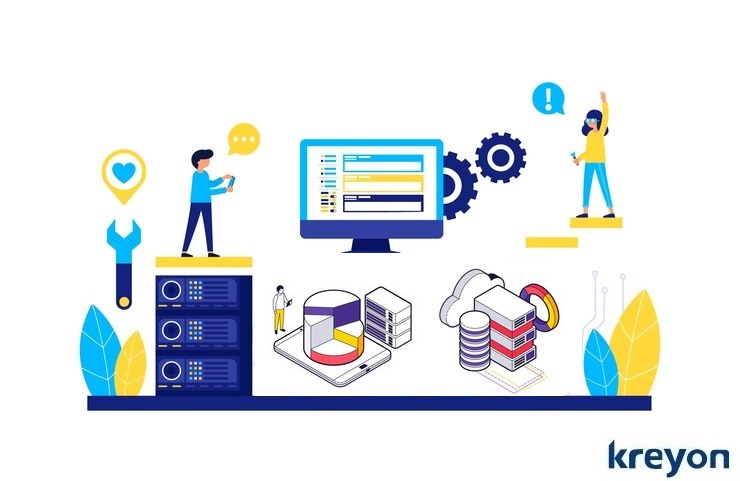Big Data Management: Strategies for Handling and Analyzing Large Datasets

Big data management is becoming an indispensable part of business in the digital era. From website clicks to sensor readings, every digital interaction generates data. Businesses now face petabytes (that’s quadrillions!) of information, demanding sophisticated strategies to harness its power.
Ignore it, and you miss out on crucial insights. Mismanage it, and you get lost in a labyrinth of overwhelming numbers.
As businesses are inundated with vast amounts of data generated at an unprecedented rate. The challenge lies not only in collecting this data but also in effectively managing and analyzing it to extract valuable insights.
This is where big data management strategies come into play, offering businesses the tools to navigate and harness the potential of massive datasets.
Understanding the Big Data Landscape
Big data is characterized by its volume, velocity, variety, and complexity. Managing and analyzing large datasets require robust strategies that can handle structured and unstructured data arriving at high speeds. The following key strategies can empower organizations to make sense of the data deluge.
Before diving in, define your objectives. Are you looking for customer trends, predicting equipment failures, or optimizing marketing campaigns? Knowing your endgame guides your data collection and analysis methods.
Build the Data Foundation
To effectively manage big data, organizations must first establish a streamlined process for data collection. This involves gathering information from diverse sources, including social media, IoT devices, and traditional databases.
Integration tools such as Apache Kafka or Apache NiFi can help harmonize data from various origins into a centralized repository.
Scalable Storage Systems

As data volumes grow, so does the need for scalable storage solutions. Distributed file systems like Hadoop Distributed File System (HDFS) or cloud-based storage services such as Amazon S3 provide the scalability required to accommodate the expanding datasets.
Cloud platforms like Google Cloud Platform (GCP), Amazon Web Services (AWS), and Microsoft Azure offer scalable storage, processing power, and analytics tools. Invest in reliable hardware and secure network infrastructure to handle the data flood.
Data Quality and Cleaning
Raw data is messy. Implement data cleansing and preprocessing techniques to remove duplicates, correct errors, and format it for analysis. This ensures quality and accuracy in your downstream insights.
Maintaining data quality is paramount for meaningful analysis. Implementing data cleaning processes helps ensure accuracy and consistency. Techniques such as outlier detection and error correction algorithms can enhance the reliability of the dataset.
Data Governance and Security
Your data is a precious asset. Implement robust security measures like encryption, access controls, and intrusion detection to protect it from unauthorized access and breaches.
Big data often contains sensitive information, necessitating robust data governance and security measures. Organizations must implement access controls, encryption, and auditing mechanisms to safeguard data integrity and comply with privacy regulations.
Analyzing Big Data

Analyzing large datasets involves extracting meaningful patterns, trends, and insights. Advanced analytics techniques and tools play a crucial role in unraveling the potential within big data.
Numbers alone can be dry. Turn your findings into compelling visuals like charts, graphs, and interactive dashboards. This makes data accessible and impactful for decision-making.
Distributed Computing
Big data analytics often requires immense computational power. Distributed computing frameworks like Apache Spark or Hadoop MapReduce allow organizations to process large datasets across clusters of machines, enabling parallel processing for faster and more efficient analysis.
Data Visualization
Communicating insights effectively is as crucial as uncovering them. Data visualization tools such as Tableau or Power BI transform complex datasets into understandable visuals, making it easier for decision-makers to grasp and act upon the information.
Depending on your goals, different analysis tools come into play. Predictive analytics reveal future trends, statistical analysis uncovers hidden patterns, and machine learning automates insights without explicit programming.
Real-time Analytics

In today’s fast-paced business environment, real-time analytics is imperative. Technologies like Apache Flink or Apache Storm enable organizations to analyze data as it is generated, facilitating quicker decision-making and responsiveness to changing trends.
While big data management strategies have come a long way, challenges persist. The growing complexity of data ecosystems, ensuring data privacy, and addressing ethical concerns are ongoing considerations.
Automated Machine Learning
Looking ahead, several trends are shaping the future of big data management: Machine learning algorithms empower organizations to uncover hidden patterns within big data.
Whether it’s predicting customer behavior or identifying trends, machine learning algorithms enhance the analytical capabilities, providing actionable insights.
As the demand for machine learning capabilities increases, automated machine learning (AutoML) is emerging as a trend.
AutoML tools automate the process of model selection, training, and deployment, making machine learning accessible to a broader audience.
Conclusion
Big Data Management is an ongoing process. Be prepared to adapt your strategies and tools as your data needs evolve. Staying agile and open to learning keeps you afloat in the ever-changing data landscape.
Effectively handling and analyzing large datasets require a comprehensive approach that spans data collection, storage, analysis, and visualization.
With the right strategies and technologies, organizations can transform big data into a valuable asset, gaining insights that drive innovation and competitive advantage.
As we navigate the future, staying abreast of emerging trends will be crucial to mastering the ever-evolving landscape of big data management.
Kreyon Systems is a trusted partner to develop custom ERP, CRM, and data analytics platforms for enterprise customers. If you have any queries, please reach out to us.
